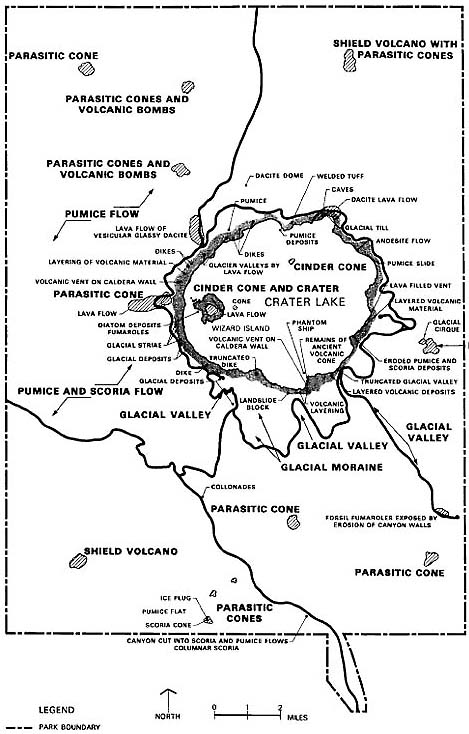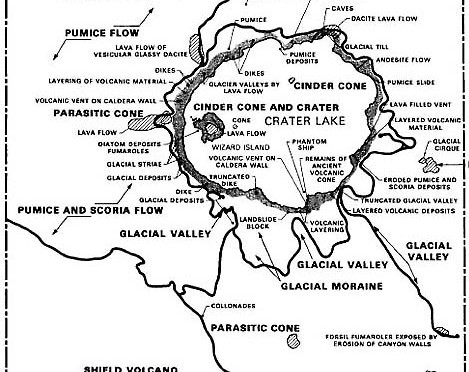Volcanism has played a major role in shaping the current landscape of Crater Lake National Park. In this section we discuss the process of volcanism and look at some of the volcanic features highlighting the volcanic processes at Crater Lake National Park.

|
Features and Landforms |
||
| Volcano Types
shield composite (stratovolcano) caldera/volcanic crater crater lake submarine volcano cinder cone spatter cone lava dome parasitic |
Lava Flow Features
columnar jointing lava channel lava falls lava flow lava tube tumulus Volcanic Plug (neck) Volcanic Plateau |
Vent Features
hot springs (hydrothermal) fumaroles (hydrothermal) volcanic fissure/linear vent Intrusions sills dikes batholiths |
| Pyroclastic flow (Ash Flow)
nuee ardentes pumice flow pyroclastic surge pyroclastic fall pyroclastic flow lahar |
Other Features
Carbonized log |
|
|
Volcanic Ejecta Classification |
| steam
gases lava/flows – by texture (pahoehoe, etc.) and by composition (andesite, basalt, etc.) pyroclasts – bombs, blocks, lapilli, ash tephra Debris avalanches, landslides, tsunami Ash, dust (smallest) pumice/pumice slides/pumice deposits Blocks and Bombs Lapilli Cinders (Scoria) Ash Flow Welded Tuff Lahars, Nuees Ardentes/Pyroclastic Flow Blocks and Bombs
pyroclastic rocks – tuff/Ash tuff, Lapilli tuff, Tuff breccia, Pyroclastic breccia, Agglomerate, Agglutinate, welded tuff tephra characterized by physical attributes – pele’s tears, pele’s hair, pumice, scoria, splatter, reticulite |
Rock Types – basalt/gabbro, granite/rhyolite, andesite/diorite, peridotite, obsidian, porphyry, rhyolite, Basaltic-Andesite, Basalt – mafic
Volcanic ejecta Classification
Definitions
- hydrothermal vent – fissure in planet’s surface from which geothermally heated water issues
- Lahar – mudflow or landslide of pyroclastic material and water
- Pluton – intrusive igneous rock that crystallized from a magma slowly cooling below the surface of the Earth. Plutons include batholiths, dikes, sills, laccoliths, lopoliths, and other igneous bodies. In practice, “pluton” usually refers to a distinctive mass of igneous rock, typically kilometers in dimension, without a tabular shape like those of dikes and sills. Batholiths commonly are aggregations of plutons. The most common rock types in plutons are granite, granodiorite, tonalite, and quartz diorite
- Pyroclastic flow – dense, hot mixture of volcanic rock fragments and gases, driven by gravity, that flows down a volcano’s flank at high speeds
- Pyroclastic rock – consolidation of pyroclastic accumulations into rock type; unconsolidated pyroclasts can be welded, compacted, or cemented into a coherent pyroclastic rock. The nongenetic classification of pyroclastic rocks is partly based on the relative abundance of the incorporated pyroclast types discussed above
- tuff/Ash tuff – rock dominated by ash; sometimes simply referred to as tuff
- Lapilli tuff – rock dominated by lapilli. Same as lapillistone?
- Tuff breccia – rock containing 25% to 75% blocks and/or bombs
- Pyroclastic breccia – rock containing at least 75% blocks and bombs
- Agglomerate – rock containing at least 75% bombs
- Agglutinate – rock composed of fused, largely unrecognizable, basalt spatter fragments
- Pyroclasts – any fragment ejected during eruption; individual eruptive fragments; fragments generated by disruption as result of volcanic action; the various types of pyroclasts are defined by their size: bombs, blocks, lapilli, ash grains
- pyroclastic deposits – defined as assemblage of pyroclasts which may be consolidated or unconsolidated. When they are consolidated they are called pyroclastic rocks. When unconsolidated they are called tephra
- Tephra/Pyroclastics – air-fall material regardless of composition or size, unconsolidated. Tephra is typically rhyolitic, as most explosive volcanoes are the product of the more viscous felsic or high silica magmas. Volcanologists also refer to airborne fragments as pyroclasts or clasts. Once clasts have fallen to the ground they remain as tephra unless hot enough to fuse together into pyroclastic rock or tuff; generic term for airborne pyroclastic accumulations
- Tuff – consolidated ash; breccias, welded tuff, rhyolite tuffs, andesite tuffs, etc.
- Tumuli – raised lava crust caused by pressure from fluid lava accumulating beneath
- pele’s tears – small pieces of solidified lava drops formed when airborne particles of molten material fuse into tearlike drops of volcanic glass. Pele’s tears are jet black in color and are often found on one end of a strand of Pele’s hair.
- pele’s hair – volcanic glass threads or fibers formed when small particles of molten material are thrown into the air and spun out by the wind into long hair-like strands. The diameter of the strands is less than 0.5 mm, and they can be as long as 2 meters. Pele’s hair is deep yellow or gold and commonly found downwind from active vents.
- splatter – Impact of molten spatter fragments hitting the ground and flattening into roughly circular disks
- pumice – textural term for a volcanic rock that is a solidified frothy lava typically created when super-heated, highly pressurized rock is violently ejected from a volcano. It can be formed when lava and water are mixed. This unusual formation is due to the simultaneous actions of rapid cooling and rapid depressurization. The depressurization creates bubbles by lowering the boiling point of the lava (akin to the bubble-creation when a carbonated drink is opened). The simultaneous cooling then freezes the bubbles in the matrix.
- scoria – Scoria differs from pumice in being denser, with larger vesicles and thicker vesicle walls; it sinks rapidly.
- reticulite – Frothy basaltic rock sometimes called basalt pumice or thread-lace scoria. This delicate rock forms during vigorous fire-fountaining. Reticulite has the lowest density of any rock, with a porosity (vesicularity) up to 98 percent. The open honeycomb network of bubbles (vesicles) results from the bursting of cell walls against one another during vesiculation.
Other pages in this section
*** previous title *** --- *** next title ***


